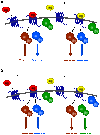Agonist-selective mechanisms of GPCR desensitization
- PMID: 18059321
- PMCID: PMC2268061
- DOI: 10.1038/sj.bjp.0707604
Agonist-selective mechanisms of GPCR desensitization
Abstract
The widely accepted model of G protein-coupled receptor (GPCR) regulation describes a system where the agonist-activated receptors couple to G proteins to induce a cellular response, and are subsequently phosphorylated by a family of kinases called the G protein-coupled receptor kinases (GRKs). The GRK-phosphorylated receptor then acts as a substrate for the binding of a family of proteins called arrestins, which uncouple the receptor and G protein so desensitizing the agonist-induced response. Other kinases, principally the second messenger-dependent protein kinases, are also known to play a role in the desensitization of many GPCR responses. It is now clear that there are subtle and complex interactions between GRKs and second messenger-dependent protein kinases in the regulation of GPCR function. Functional selectivity describes the ability of agonists to stabilize different active conformations of the same GPCR. With regard to desensitization, distinct agonist-activated conformations of a GPCR could undergo different molecular mechanisms of desensitization. An example of this is the mu opioid receptor (MOPr), where the agonists morphine and [D-Ala(2),N-MePhe(4),Gly-ol(5)]enkephalin (DAMGO) induce desensitization of the MOPr by different mechanisms, largely protein kinase C (PKC)- or GRK-dependent, respectively. This can be best explained by supposing that these two agonists stabilize distinct conformations of the MOPr, which are nevertheless able to couple to the relevant G-proteins and produce similar responses, yet are sufficiently different to trigger different regulatory processes. There is evidence that other GPCRs also undergo agonist-selective desensitization, but the full therapeutic consequences of this phenomenon await further detailed study.
Figures




Similar articles
-
μ-Opioid receptor desensitization: homologous or heterologous?Eur J Neurosci. 2012 Dec;36(12):3636-42. doi: 10.1111/ejn.12003. Epub 2012 Sep 24. Eur J Neurosci. 2012. PMID: 23002724 Free PMC article.
-
Role of G Protein-Coupled Receptor Kinases 2 and 3 in μ-Opioid Receptor Desensitization and Internalization.Mol Pharmacol. 2015 Aug;88(2):347-56. doi: 10.1124/mol.115.098293. Epub 2015 May 26. Mol Pharmacol. 2015. PMID: 26013542 Free PMC article.
-
Agonist-selective mechanisms of mu-opioid receptor desensitization in human embryonic kidney 293 cells.Mol Pharmacol. 2006 Aug;70(2):676-85. doi: 10.1124/mol.106.022376. Epub 2006 May 8. Mol Pharmacol. 2006. PMID: 16682505
-
G protein-coupled receptor interactions with arrestins and GPCR kinases: The unresolved issue of signal bias.J Biol Chem. 2022 Sep;298(9):102279. doi: 10.1016/j.jbc.2022.102279. Epub 2022 Jul 19. J Biol Chem. 2022. PMID: 35863432 Free PMC article. Review.
-
Evolving concepts in G protein-coupled receptor endocytosis: the role in receptor desensitization and signaling.Pharmacol Rev. 2001 Mar;53(1):1-24. Pharmacol Rev. 2001. PMID: 11171937 Review.
Cited by
-
The incidence of candidate binding sites for β-arrestin in Drosophila neuropeptide GPCRs.PLoS One. 2022 Nov 1;17(11):e0275410. doi: 10.1371/journal.pone.0275410. eCollection 2022. PLoS One. 2022. PMID: 36318573 Free PMC article.
-
Characterising the mechanism of airway smooth muscle β2 adrenoceptor desensitization by rhinovirus infected bronchial epithelial cells.PLoS One. 2013;8(2):e56058. doi: 10.1371/journal.pone.0056058. Epub 2013 Feb 15. PLoS One. 2013. PMID: 23457497 Free PMC article.
-
Differential development of antinociceptive tolerance to morphine and fentanyl is not linked to efficacy in the ventrolateral periaqueductal gray of the rat.J Pain. 2012 Aug;13(8):799-807. doi: 10.1016/j.jpain.2012.05.005. Epub 2012 Jul 3. J Pain. 2012. PMID: 22766006 Free PMC article.
-
Different conformational responses of the β2-adrenergic receptor-Gs complex upon binding of the partial agonist salbutamol or the full agonist isoprenaline.Natl Sci Rev. 2020 Nov 24;8(9):nwaa284. doi: 10.1093/nsr/nwaa284. eCollection 2021 Sep. Natl Sci Rev. 2020. PMID: 39040950 Free PMC article.
-
Ligand-directed signalling within the opioid receptor family.Br J Pharmacol. 2012 Nov;167(5):960-9. doi: 10.1111/j.1476-5381.2012.02075.x. Br J Pharmacol. 2012. PMID: 22708627 Free PMC article. Review.
References
-
- Ally RA, Ives KL, Traube E, Eltounsi I, Chen PW, Cahill PJ, et al. Agonist- and protein kinase C-induced phosphorylation have similar functional consequences for gastrin-releasing peptide receptor signaling via Gq. Mol Pharmacol. 2003;64:890–904. - PubMed
-
- Bailey CP, Kelly E, Henderson G. Protein kinase C activation enhances morphine-induced rapid desensitisation of mu-opioid receptors in mature rat locus ceruleus neurons. Mol Pharmacol. 2004;66:1592–1598. - PubMed
-
- Bailey CP, Smith FL, Kelly E, Dewey WL, Henderson G. How important is protein kinase C in mu-opioid receptor desensitisation and morphine tolerance. Trends Pharmacol Sci. 2006;27:558–565. - PubMed
Publication types
MeSH terms
Substances
Grants and funding
LinkOut - more resources
Full Text Sources
Research Materials

